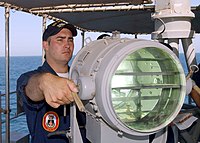
Photo from wikipedia
In satellite laser communication systems, accurate positioning of the beacon is essential for establishing a steady laser communication link. For satellite-to-ground optical communication, the main influencing factors on the acquisition… Click to show full abstract
In satellite laser communication systems, accurate positioning of the beacon is essential for establishing a steady laser communication link. For satellite-to-ground optical communication, the main influencing factors on the acquisition of the beacon are background noise and atmospheric turbulence. In this paper, we consider the influence of background noise and atmospheric turbulence on the beacon in satellite-to-ground optical communication, and propose a new locating algorithm for the beacon, which takes the correlation coefficient obtained by curve fitting for image data as weights. By performing a long distance laser communication experiment (11.16 km), we verified the feasibility of this method. Both simulation and experiment showed that the new algorithm can accurately obtain the position of the centroid of beacon. Furthermore, for the distortion of the light spot through atmospheric turbulence, the locating accuracy of the new algorithm was 50% higher than that of the conventional gray centroid algorithm. This new approach will be beneficial for the design of satellite-to ground optical communication systems.
Journal Title: Optics express
Year Published: 2017
Link to full text (if available)
Share on Social Media: Sign Up to like & get
recommendations!